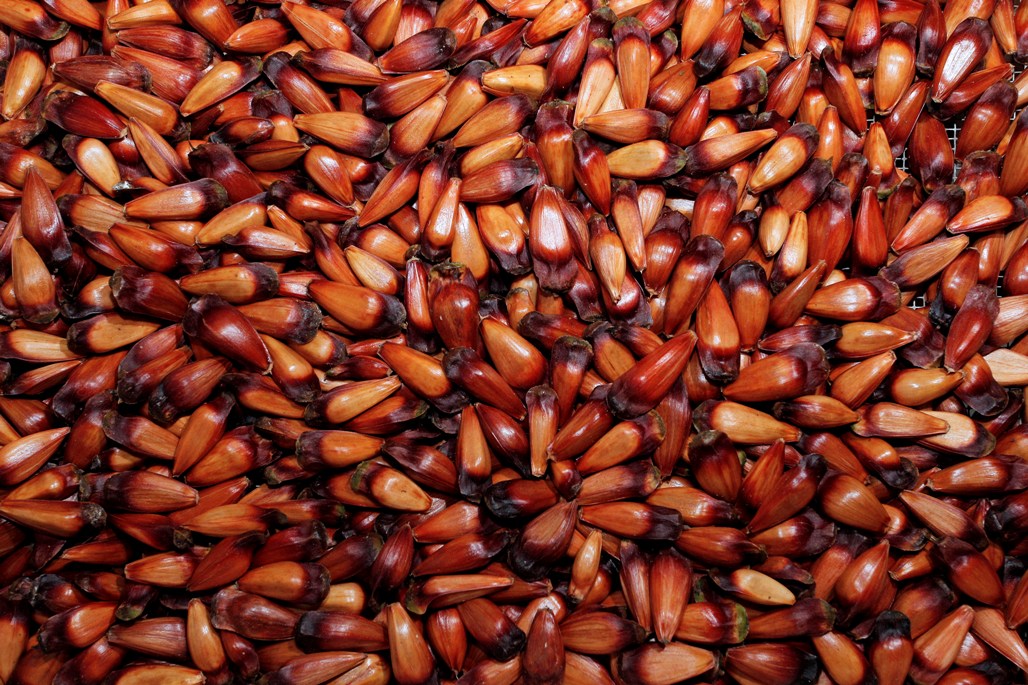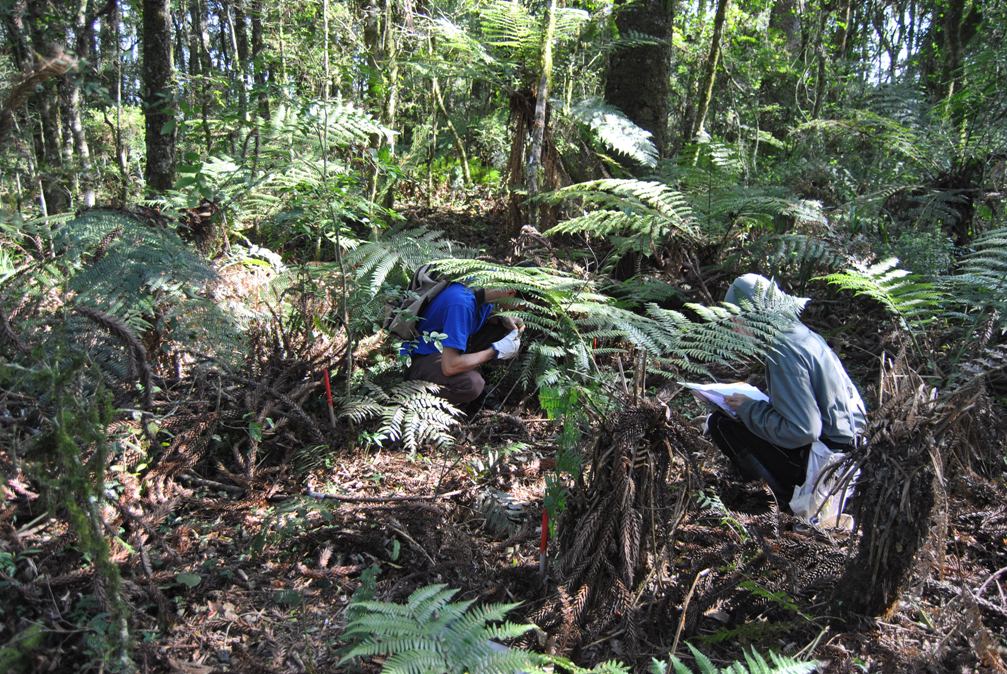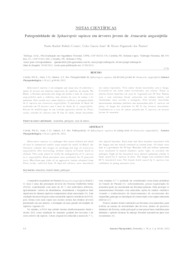Research can reverse the Brazilian pine threat of extinction
Research can reverse the Brazilian pine threat of extinction
Photo: Luiz Costa

The Brazilian pine is a typical tree of southern Brazil and is in the list of endangered species.
This is the Brazilian pine (Araucaria angustifolia), also known as the Paraná pine and it is part of the ecosystem known as Araucaria Moist Forests. Originally, this forest covered an area of about 200,000 km², with a more continuous distribution between the states of Paraná, Santa Catarina and Rio Grande do Sul, and a sparse and irregularly one in the Southeast. Today, the Araucaria Moist Forests is reduced to about 1% of its original area and one of the species that suffered most was the Brazilian pine.
The exploitation of the species was because of the expansion of agriculture, the growth of cities, by having quality wood for furniture and being good raw material for pulp and paper. For all this, the species was exploited as it has been on the list of threatened Brazilian species.
In Paraná, for example, the law allows to be cut only the Brazilian pine that its planting can be proven - which means to be planted in line with the management plan and registered with the competent environmental agency. Brazilian pines born by natural regeneration are considered native and can not be handled or cut. "But as it is a species that regenerates well, that is, born alone without someone to plant, often the plantlet is plucked once born just because it can not be handled or used later on", explains the researcher Ivar Wendling from Embrapa Forestry. "The farmer understands it as something that is taking up space on his property and the Brazilian pine becomes an unwanted tree", he adds.
What if, instead, the farmer could see in the Brazilian pine a possibility of management and income, even with those that regenerate naturally? "In this case, the producer will want that plantlet to grow and develop and may also invest in plantations" says Wendling. "Today, it is the best way to ensure the development of Brazilian pines population," says researcher Valderes de Sousa. For this, a group of researchers from Embrapa Forestry are dedicated to develop technology so that the Brazilian pine can be preserved and also generate income. It is the concept "storing by using" being defended. "Even with trees being cut down for timber use, for example, the interest in the species can grow so large that, in no time, the species most likely will not be endangered," says Wendling.
To this end, the forestry research has made use of different strategies, ranging from genetic improvement and forest management, through cloning and cryopreservation, to encouraging companies to pay for environmental services provided by producers, as well as studies on the consumption of pinion, among others. "As forestry research usually takes longer to get to their results, we operate on several fronts with the intention of facilitating the use of the species and provide subsidies for the change in law," emphasizes the head of Research and Development of Embrapa Forestry, Sergio Gaiad. All this so that Brazilian pine is seen as an ally of the farmer and is free from risk of extinction.
 Family farmers make participatory forest management of the Brazilian pine
Family farmers make participatory forest management of the Brazilian pine
No one better to know a tree than the one that observes and lives with it day by day. That's the premise of participatory forest management, central point of the "Use and preservation of the Brazilian pine in family farming", coordinated by Embrapa Forestry. Producers from Bituruna, Cruz Machado and São Mateus do Sul (PR), and Canoinhas and Hunter (SC) are participating of the project.
"Farmers are helping us to identify trees with different characteristics: early and late production of pinion, trees with superior growth, among others", explains the researcher and project leader Maria Izabel Radomski. Seeds have been collected in ten properties by the producers themselves.
Anísio Rosa, settled in rural area for 25 years, says that he harvests the pinions from trees he planted as soon as he entered the lot and also the others that already existed originally in the region. "I am slowly coming out of agriculture and investing more in the forest, especially in Brazilian pine and yerba mate", says the producer. "We can not think only of the immediate, but also long investment and the Brazilian pine is a great alternative", Anísio teaches us. The producer is helping in identifying parent trees with production of pinion in different seasons. "We have identified five parent trees here on my property. This is a way to help us expand the use of this very important tree here for our region", he concludes.
An innovation that is being implemented in this project is the analysis of the distribution of trees in forest areas managed by farmers. Images in reduced scaled are made to act as an aerial view of treetops. With this feature, the producer can better understand where the gaps, the glades, overlaps in his area are. "It will be possible to discuss the handling spatially and the producer can make the modeling of their property without compromising the area with inadequate management", says Radomski.
The first experience of this methodology happens in five properties. Models of integrating the Brazilian pine to traditional production systems of small farmers will be discussed, either through pure plantations or agroforestry systems, taking the Brazilian pine as a source of diversification in the income of properties.
Rural landscaping, carbon sequestration and guaranteed financial return to farmers
Preserve the Brazilian pine, increase the income, help reducing the impact of climate change and support forestry research. A distant dream? Not for 65 farmers of Lapa e Irati (PR) and Caçador (SC) participating in the "Roads with Brazilian pines" project, which encourages the planting of the species on borders of farms with road tracks. Farmers plant 200 seedlings of Brazilian pine for property and get R$ 5 each of them, for a total and fixed income of R$ 1,000 per year and comprising from planting trees to complete their development and start producing pinions. It is called payment for environmental services (PES). "The payment is made by private companies, using mostly the trees to offset emissions of greenhouse gases of its operations," explains Edilson Batista de Oliveira, a researcher at Embrapa Forestry and creator of the project. In three years, somewhere about 20,000 seedlings of the Brazilian pine have already been planted.
 Result of partnerships with state agencies and universities in Paraná and Santa Catarina, Roads with Brazilian pines is one of the only projects in the country that actually makes the payment for environmental services. "We have secured resources for the next ten years for producers who already participate", celebrates Oliveira. The DSR Group sponsors the project. According to Paulo Caffeu, general manager of the Group, "the project makes possible the application of the practice of social responsibility of the Group with the remuneration of the families involved and their benefits, and also enables the use of design as a sustainable model."
Result of partnerships with state agencies and universities in Paraná and Santa Catarina, Roads with Brazilian pines is one of the only projects in the country that actually makes the payment for environmental services. "We have secured resources for the next ten years for producers who already participate", celebrates Oliveira. The DSR Group sponsors the project. According to Paulo Caffeu, general manager of the Group, "the project makes possible the application of the practice of social responsibility of the Group with the remuneration of the families involved and their benefits, and also enables the use of design as a sustainable model."
The single-row plantings in borders with roads integrate well with agricultural activities, serving, for example, as living fences, and to providing thermal comfort for cattle. Furthermore, Brazilian pines planted in rows are excellent producers of pinions, which are increasingly valued in the market. "Another positive result is that many producers by their own initiative have planted pines in the borders of their properties because of the benefits these trees provide," says Oliveira.
The return to society is guaranteed: the Brazilian pine plantation also assists in the landscaping of roads, environmental protection, benefits the local fauna and acts in environmental education. For producers, in addition to the resource guaranteed by the PSA, there is a higher return by selling the pinion. For forest research, these plantations have contributed studies on conservation, management and genetic improvement.
Katia Regina Pichelli
Embrapa Forestry
Press inquiries
katia.pichelli@embrapa.br
Phone number: (41) 3675-5638
Further information on the topic
Citizen Attention Service (SAC)
www.embrapa.br/contact-us/sac/

